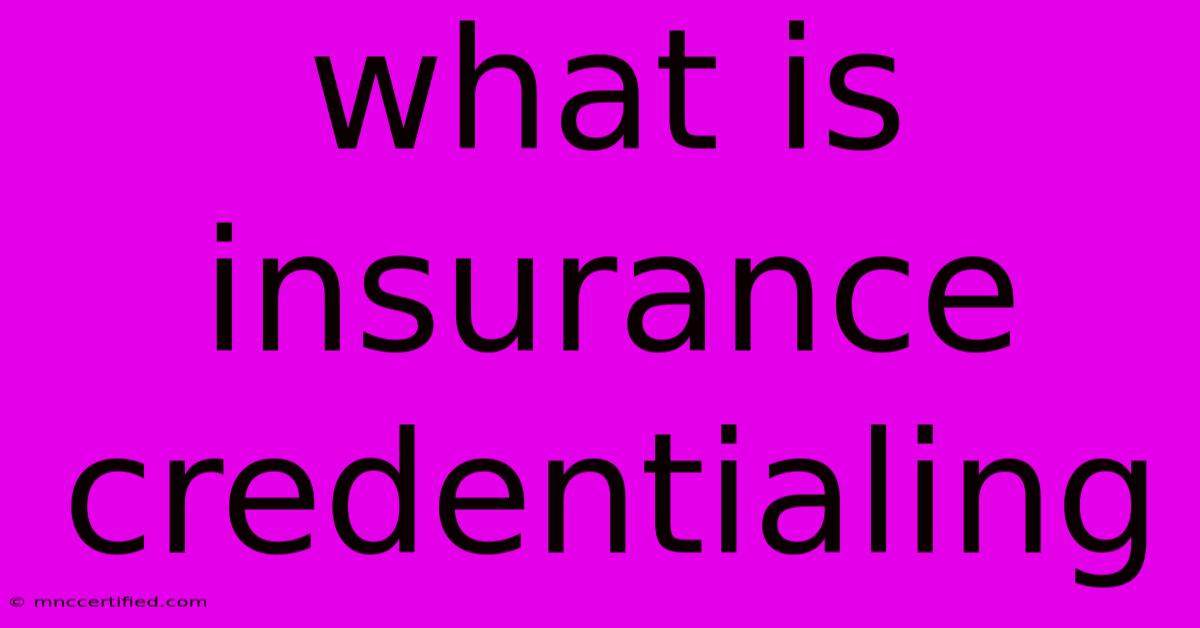What Is Insurance Credentialing

Table of Contents
What is Insurance Credentialing? A Complete Guide for Healthcare Providers
Insurance credentialing is a crucial process for healthcare providers seeking to bill insurance companies for their services. It's essentially the process of verifying your qualifications and experience to become an in-network provider for a specific insurance plan. This allows patients with that insurance to utilize your services and have their claims processed smoothly, often at a lower cost than out-of-network care. Think of it as getting your "stamp of approval" from insurance companies. This comprehensive guide will delve into the intricacies of insurance credentialing, outlining its importance, the steps involved, and common challenges.
Why is Insurance Credentialing Important?
Credentialing is not just a formality; it’s a vital step to ensure your practice's financial stability and growth. Here's why:
- Increased Patient Access: Being in-network significantly broadens your patient base, as many patients prefer or are required to use in-network providers due to their insurance plans' coverage.
- Streamlined Billing and Payments: In-network providers benefit from simplified billing processes and faster reimbursements, improving your cash flow.
- Higher Reimbursement Rates: Insurance companies typically reimburse in-network providers at higher rates compared to out-of-network providers.
- Enhanced Professional Reputation: Being credentialed with major insurance providers demonstrates your commitment to quality care and professional standards.
- Competitive Advantage: In a competitive healthcare market, being in-network with a wide range of insurance plans gives you a significant advantage.
The Insurance Credentialing Process: A Step-by-Step Guide
The credentialing process can seem daunting, but breaking it down into manageable steps makes it much more approachable. The specific requirements vary by payer (insurance company), but the general process usually includes:
1. Choosing Your Payers:
Research and select the insurance plans most relevant to your patient demographic and practice specialty. Consider factors like market share and reimbursement rates.
2. Gathering Required Documents:
This is the most time-consuming part. You'll need to assemble a comprehensive collection of documents, including:
- Application: Complete and accurate application forms are crucial. Errors can delay the entire process.
- Medical License and Certification: Proof of licensure and any relevant certifications in your state.
- Education and Training Records: Transcripts and diplomas verifying your qualifications.
- Malpractice Insurance: Proof of active and adequate malpractice insurance coverage.
- Curriculum Vitae (CV) or Resume: A detailed overview of your professional experience and accomplishments.
- Facility Information: Details about your practice location, including photos and facility details.
- References: Letters of recommendation from colleagues or supervisors.
- Background Checks: You may need to undergo background checks and criminal history screenings.
3. Completing the Application:
Pay close attention to detail. Inaccuracies can lead to delays or rejection. Ensure all information is accurate and up-to-date.
4. Submitting Your Application:
Submit the application and supporting documents according to the payer's instructions. Keep copies of everything for your records.
5. Monitoring the Process:
Stay in contact with the payer's credentialing department to track the progress of your application. Be prepared to address any questions or requests promptly.
6. Recredentialing:
Credentialing isn't a one-time event. You'll typically need to undergo recredentialing periodically to maintain your in-network status. This usually involves updating your information and providing proof of continued compliance.
Common Challenges in Insurance Credentialing
Navigating the credentialing process can be complex. Common challenges include:
- Extensive Paperwork: The sheer volume of paperwork can be overwhelming.
- Conflicting Requirements: Different payers may have different requirements, creating inconsistencies.
- Long Processing Times: The entire process can take several months, even years, depending on the payer.
- Frequent Updates and Changes: Payer requirements can change frequently, demanding constant attention.
Streamlining the Credentialing Process
To make the process more efficient, consider these strategies:
- Utilize Credentialing Services: Professional credentialing services can manage much of the paperwork and communication.
- Invest in Credentialing Software: Specialized software can help track applications and deadlines.
- Maintain Accurate Records: Keeping your records organized and updated will save you time and hassle.
- Proactive Communication: Regular communication with payers can resolve issues promptly.
Conclusion:
Insurance credentialing is a critical aspect of running a successful healthcare practice. While it can be a complex and time-consuming process, understanding the steps and potential challenges, along with implementing effective strategies, can greatly improve your chances of a smooth and efficient credentialing experience, ultimately leading to a more robust and thriving practice. Remember, proactive planning and attention to detail are key to success.

Thank you for visiting our website wich cover about What Is Insurance Credentialing. We hope the information provided has been useful to you. Feel free to contact us if you have any questions or need further assistance. See you next time and dont miss to bookmark.
Featured Posts
-
24 Illinois Edges Rutgers Road Victory
Nov 24, 2024
-
Hearts 1 4 Celtic Match Recap
Nov 24, 2024
-
Buckeyes Rout Indiana In Football Matchup
Nov 24, 2024
-
Insurance Lounge Medford Oregon
Nov 24, 2024
-
Cheap Auto Insurance Modesto Ca
Nov 24, 2024